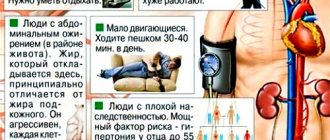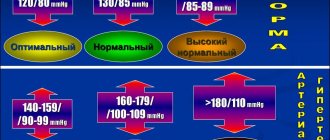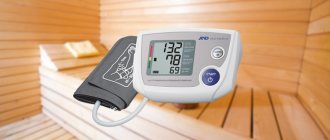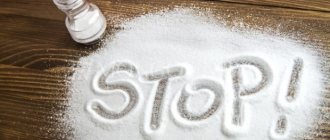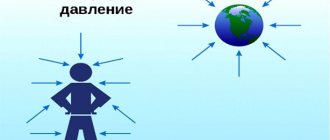Hypotension is the professional term for low blood pressure. We are talking about hypotension when measuring values below 100/60 (sometimes a pressure of 90 to 50 is indicated as a limit). With low pressure (90 over 50, 100 over 50, 54 and below), some important organs, in particular the brain or kidneys, do not receive enough blood and nutrition. Reduced blood pressure can worsen life, cause dizziness, spots before the eyes, tinnitus, and cold extremities.
Lowering blood pressure to 90/50 - what does this mean?
If the pressure readings are 90 to 50, what does this mean? In hypotension, the measured values are less than 110/70. Therefore, when the systolic value is 90 (80, 70 or less), the diastolic value is below 70 (60, 53, 48, 45), hypotension is diagnosed. The disorder is characterized by slow pumping of blood in the body. Due to a slowdown in metabolism, the body needs more time to adapt to a new situation, condition, and body position. Because of the slow flow, the body needs to concentrate more blood on simple processes. This is manifested by increased fatigue after eating, during meals. At a pressure of 90 to 50, a disruption of the blood supply to the brain occurs (not life-threatening).
Why is low blood pressure dangerous?
In addition to deteriorating well-being, with a constant pressure of 90 to 50, the brain does not receive enough oxygen and blood, which can cause cardiogenic shock, fainting and, as a result, cerebral stroke. Over the years, low blood pressure levels lead to a restructuring of the body, after which hypotension often turns into hypertension. Former hypertensive patients endure pressure surges much more severely than people with chronically high blood pressure.
Lower 50
Low diastolic pressure can provoke hypoxia of internal vital organs. Reduced indicators may indicate pathological processes in the body such as impaired renal function, arterial hypotension, varicose veins, chronic somatic diseases, various inflammations or infections and the presence of malignant tumors. A single manifestation of low diastolic pressure indicates a lack of water in the body or a long stay in a stuffy room or in the sun.
Upper 90
A low systolic indicator indicates the development of serious cardiac or renal pathologies, including arrhythmia, tachycardia, bradycardia, and heart valve diseases. The top number gives detailed information about the intensity of the heart “pump”. You can understand how great the threat to health is by measuring your blood pressure. When the systolic reading is below 60, the patient may lose touch with reality, his legs become weak, his vision becomes cloudy, and he loses consciousness. It is important to provide the patient with medical care in a timely manner, because the person may die.
90/50 during pregnancy
When a pregnant woman’s blood pressure drops to 90/50, she urgently needs to see a doctor. In addition to poor health, the fetus lacks oxygen, which can lead to disruptions in its development and complications during childbirth. When blood circulation in the placenta is disrupted, placental insufficiency occurs, and the child experiences oxygen starvation and begins to suffocate. The worst case scenario for hypotension is a miscarriage in late pregnancy. The development of gestosis is another complication that leads to disruption of the systems and organs of a woman’s body.
BP 90/50 with normal heart rate
If a pressure of 90 over 50 accompanies a normal pulse, this condition is not life-threatening. But it is characterized by unpleasant accompanying manifestations, such as:
- headache;
- dizziness;
- nausea;
- fatigue;
- constantly cold extremities.
Low blood pressure with a normal pulse is more common in young women and girls. The problem is common in thinner people, who may feel tired even with slight exertion. This means that people (i.e. their organs) do not have enough nutrients carried in the blood.
Hypotension: debunking myths
One day a patient comes to see a doctor, and he records low blood pressure - 90 over 50 . Could this be possible? Maybe, because one patient feels the symptoms of hypotension vividly, they literally incapacitate him. Another notes them as background, unexpressed, which means there is no point in looking for the cause of the ailment. Therefore, as doctors say, you can “become hypotensive suddenly.”
If you are diagnosed with hypotonic symptoms, and the numbers on the tonometer confirm it, it is very important not to become hostage to the speculation and false assumptions surrounding this pathology.
Myth or truth:
- If I feel overwhelmed and have a headache, it's definitely hypotension. But that’s not true! The same picture can accompany hypertension and other diseases and conditions that are not significantly reflected in blood pressure readings. And heaviness in the back of the head, and aching/stabbing sensations behind the sternum, and loss of appetite, and irritability - all of the above can relate to both hypotonic and hypertonic signs.
- Blood pressure below 120/80 – it’s time to get treatment. A clear myth, and a dangerous one at that! By the way, the medical community today does not consider 120/80 an ideal pressure. This is the norm, a good indicator, but the optimal values will be slightly lower - 110/70-75, for example. Therefore, even 100/70 is not hypotension, but blood pressure is within normal limits. Another question is if you had 160/90 in the morning, and after taking the pill it became 100/70 – too sharp a decrease is dangerous.
- Hypotonic patients should drink several cups of coffee every day. Coffee can indeed raise your blood pressure for a while, but if you “pump up” on it, you will develop many other problems besides low blood pressure. If you suffer from low blood pressure, you can simply drink a cup of sweet black tea (or green) and eat a sandwich with cheese and butter. To increase blood pressure, cheese is an ideal combination of fat and salt. By the way, hypotensive people should not go hungry: their diet involves 4 meals (at least 4).
- Hypotension compared to hypertension is nonsense. And such a statement “walks” on the Internet, and it would be okay if only on the Internet. Hypotension has many negative aspects. For example, people with this diagnosis have a more difficult time with acclimatization and magnetic storms. Hypotension occurs more often in young people; over the years, it can quite abruptly turn into hypertension. And former hypotensive patients are more sensitive to pressure surges.
- Hypotonic patients are not at risk of hypertension. As noted in the previous paragraph, this is not the case. Hypotension does not at all guarantee that the patient will never encounter hypertensive disease. Moreover, such a significant change complicates the course of hypertension; the former hypotensive patient feels even not the highest blood pressure values as extreme.
- The bath will help cope with the disease. A bathhouse, steam room, and sauna are really good vascular training. But the training must be competent, built according to certain principles. These procedures are carried out gradually, and should be stopped at the slightest discomfort. If the pressure drops sharply, which can lead to fainting.
There are a great many such myths! When you are wondering what to do if the pressure is 90 to 50, you should not collect erroneous judgments, but act wisely, strictly, and competently.
BP 90/50 with increased heart rate
A pressure of 90 over 50 accompanied by tachycardia is characteristic of a state of shock. Shock is an unfavorable response of the body to a certain situation, in which tissues suffer from a sharp lack of oxygen and nutrients. First aid is to ensure the delivery of blood to important organs. The increase in heart rate can reach 140–160 beats/min. This is a life-threatening condition that requires urgent medical attention.
Important! In such a situation, there is a risk of anaphylactic and post-traumatic shock.
What are the dangers of low blood pressure?
Some people feel great with low blood pressure. But even in such cases, you need to be careful about your health. What does low blood pressure entail? It reduces the speed of blood movement and the amount of blood entering the organs. This, in turn, causes them to become hypoxic and lack nutrition, which affects their functionality, for example, brain activity.
A person's concentration and speed of thinking decreases. Attacks of dizziness, nausea, and fainting develop. And, the main danger is that the heart becomes vulnerable to even minor physical exertion. Due to impaired peripheral circulation, a serious complication may develop - cardiogenic shock, when pressure and pulse are not determined. The person needs urgent medical attention. Another danger of chronic low blood pressure is the development of a cerebral stroke.
Blood pressure 90/50 with low heart rate
With a pressure of 90 to 50, accompanied by bradycardia, the problem is a sharp decrease in heart rate (for example, from 70 to 50 and below). This condition is more common in older age, because after 50 years, even in a healthy heart, some muscle cells can be replaced by connective tissue. Therefore, its effectiveness decreases.
If hypotension and low heart rate are not accompanied by unpleasant symptoms, there is no need to worry. But if breathing problems or severe fatigue occur, treatment is required.
Causes of low blood pressure
If blood pressure is below normal, then this condition is called hypertension or hypotension in medicine. The diagnosis is not made on the basis of numbers, but if a clinical picture is available. Often people with blood pressure readings below normal feel healthy, but this still remains a reason for examination, since low blood pressure is a symptom of many diseases. The causes of low blood pressure are numerous:
- endocrine pathologies;
- dehydration of the body;
- strict diet;
- presence of blood clots;
- pregnancy;
- severe infections;
- allergic manifestations;
- significant blood loss;
- harmful work;
- sudden weight loss;
- standing for a long time;
- heart diseases;
- sharp rise.
Permanent
Low blood pressure sometimes indicates problems in the body. There are three types of hypertension:
- Orthostatic. This means that the body cannot regulate parameters correctly and quickly. This type of pathology is characterized by a sharp jump in pressure after a change in position.
- Postprandial hypotension. Symptoms of the disease are a sudden rush of blood to the lower extremities after eating, a sharp drop in blood pressure. This indicates endocrine system disorders, changes in the brain or mental disorders.
- Vegetovascular hypertension. The diagnosis means that a person’s cardiovascular system is not working properly. More often diagnosed in adolescents.
Among women
Low heart pressure develops more often in the fair sex, especially during hormonal changes or during changes in the atmosphere. Hypotension in a woman is not always accompanied by severe symptoms and does not interfere with leading a normal lifestyle. Pressure of 90 to 50 occurs when blood vessels expand and decrease in tone, as a result of which blood circulation slows down and internal organs are not sufficiently supplied with oxygen.
In men
If a systolic pressure is 90 and a diastolic pressure is 50 in a man, then this also develops hypotension. Pathology can be primary or secondary. The first variant of the disease is independent. The reasons for the development of primary hypertension are low activity of the nervous system (vegetative) or severe psycho-emotional exhaustion. Secondary hypotension is a complication of any disease: diabetes mellitus, hypothyroidism, adrenal dysfunction and others.
For what diseases
Often, blood pressure can drop due to external causes. The main diseases in which blood pressure falls below normal:
- Vegetative-vascular dystonia. The pressure is not maintained at the level, since the lumen of the vessels does not narrow enough when environmental conditions change.
- Cerebral atherosclerosis. A similar mechanism of hypotension occurs in the elderly and elderly. With cerebral atherosclerosis, the blood supply to the vascular center deteriorates against the background of atherosclerotic changes.
- Decreased blood volume. Occurs due to blood loss or dehydration (diarrhea, vomiting, abuse of diuretics, insufficient fluid intake).
At night
Often a person’s blood pressure is 90/50 at night. Indicators fall due to circulatory failure, when the body switches to an economical mode of life during sleep. To compensate for the condition, the person’s wakefulness center is activated, and he wakes up. Waking up in the middle of the night and insomnia lead to the fact that the patient does not rest properly, and in the morning he feels tired, chills, and numbness of the limbs.
After sleep
Sleep for hypotensive patients should last at least 10 hours, especially if the weather is rainy outside and there is low atmospheric pressure. When a person wakes up, he does not need to immediately jump out of bed onto his feet, otherwise he will be guaranteed low blood pressure. To minimize a sharp drop in blood pressure, you need to lie quietly for a few minutes, then slowly lower your legs to the floor and sit for a couple more minutes, and only then get out of bed.
Reasons for blood pressure 90/50
Hypotension with indicators of 90 to 50 can occur in case of heart or vascular disorders:
- Heart failure. The heart doesn't pump enough blood into the arteries; it doesn't get to where it's needed.
- Vascular disorders. The vessels cannot properly regulate blood flow. If at any point the body needs more blood, it “takes” it from some organ.
Causes of hypotension:
- shock;
- dehydration;
- burns;
- adrenal diseases;
- neurological, cardiac disorders;
- blood loss;
- the use of certain medications, in particular diuretics, sedatives, antihypertensives (drugs for the treatment of hypertension);
- diarrhea.
Diseases that lower blood pressure
A decrease in pressure is usually associated with dilation of small vessels. Its value is influenced by many factors:
- heart function;
- release of hormones and biologically active substances into the blood;
- bacterial toxins, inflammatory substances;
- activity of the nervous system and others.
In the brain there are pressor and depressor sections, which respectively increase or decrease pressure. They act on the endocrine glands, heart, vascular tone. The combination of these factors is individual for each patient. Therefore, only a specialist can determine the true nature of the decrease in pressure.
Diseases in which a blood pressure of 90 to 50 and a pulse of 80 to 90 per minute are possible:
- cardiopsychoneurosis;
- adrenal insufficiency (Addison's disease);
- peptic ulcer and other gastrointestinal diseases;
- heart failure;
- chronic inflammatory processes, for example, tuberculosis.
A physiological decrease in blood pressure with a normal pulse can also be observed in healthy people.
In addition, the following medications can lower blood pressure and slightly increase heart rate:
- beta blockers (metoprolol, bisoprolol and others;
- diuretics (veroshpiron, hypothiazide, furosemide);
- calcium channel antagonists (nifedipine).
Cardiopsychoneurosis
Vegetative-vascular dystonia is associated with disturbances in the functioning of the autonomic nervous system, which regulates vascular tone and heart function. In this case, weakness, sweating, and rumbling in the stomach may be observed. The reasons for this condition are emotional stress, lack of sleep, head injuries, chronic foci of infection in the body.
Adrenal insufficiency
This pathology can lead to a decrease in blood ejection from the heart and a weakening of the tone of vascular smooth muscle cells. This is due to a deficiency of adrenal hormones - aldosterone and cortisol.
Diseases of the gastrointestinal tract
Diseases of the digestive system are often accompanied by arterial hypotension with an almost normal pulse. This is due to irritation of the fibers of the vagus nerve, which connects to many internal organs. As a result, the substance acetylcholine is released, which slows down the heart and reduces blood pressure. Acetylcholine directly dilates blood vessels.
Heart diseases
A decrease in pressure to 90 to 50 and a pulse of 80 per minute can be observed with some long-term inflammatory diseases of the heart, for example, endocarditis or pericarditis. In this case, bacterial toxins entering the blood cause vasodilation.
Chronic heart failure in severe cases is also accompanied by a drop in blood pressure. In these cases, rapid heartbeat is no longer observed, and the pulse remains between 80 and 90 per minute. This pathology can complicate the course of any heart disease and requires long-term treatment.
Chronic intoxication
One of the fairly common causes of low blood pressure with a pulse of 80–90 per minute is constant poisoning of the body. These may be foci of infection (for example, inflamed tonsils or dental caries), tuberculosis, and cancer. In this case, careful treatment of these diseases is necessary, after which the pressure and pulse gradually normalize.
Blood pressure 90/50 in teenagers
Pressure within ninety to fifty in a child, especially in adolescence, is common. This is due to the fact that the growing organism does not have sufficient regulatory abilities. The disorder manifests itself mainly as headaches, especially with prolonged standing. Fainting is not uncommon, most typical for adolescents with bad habits (for example, smoking).
If a teenager tends to faint frequently (several times a day), it is advisable to consult a specialist to prescribe medications. Most parents in this regard wonder whether it is safe to take pharmaceuticals at this age. Definitely, drugs will be less of an evil than possible damage from a fall.
Important! In most cases, low blood pressure in adolescents normalizes over time.
How to determine the reasons
To determine the reasons for the decrease in pressure to 90 to 50, you need to contact a cardiologist and neurologist. In rare cases, when hypotension is associated with diseases of the adrenal glands, it is treated by an endocrinologist.
List of examinations that can be prescribed to a patient with low blood pressure and a pulse of 80–90 per minute:
- electrocardiogram;
- electroencephalogram for suspected brain disease;
- blood test for hormones: thyroxine, thyroid-stimulating hormone, cortisol, aldosterone, renin;
- daily ECG monitoring;
- 24-hour blood pressure monitoring (possibly bifunctional – that is, blood pressure and ECG at the same time);
- echocardiography;
- Ultrasound of the abdominal organs, kidneys and adrenal glands;
- if a peptic ulcer or gastritis is suspected - FGDS.
Symptoms
The main problems of hypotension are due to the fact that at low pressure the supply of blood to the brain is problematic, as a result of which it is not sufficiently saturated with oxygen. However, this does not mean that blood and oxygen do not reach the brain; insufficient pressure only slows down its transfer to the organs.
The following signs may indicate hypotension:
- fatigue;
- drowsiness;
- spots before the eyes;
- headache;
- cold extremities;
- excessive sweating;
- weakness;
- dizziness (especially when standing up);
- noise in ears;
- blurred vision;
- fast shallow breathing;
- sensitivity to cold.
Contact your doctor if you notice any of the following symptoms that occur with low blood pressure:
- chest pressure;
- dyspnea;
- Strong headache;
- poor articulation;
- numbness of one half of the body;
- swelling of the lips or throat;
- body temperature above 38 °C;
- a sore throat;
- heartbeat;
- rash;
- dark chair.
What does it mean
Low blood pressure (hypotension) can occur in people of any age and gender. It is especially dangerous for elderly patients, since with age, blood pressure usually increases slightly, and a decrease can serve as a sign of the development of any serious diseases. However, a pressure of 90 over 50 is considered normal for people who are professionally involved in sports, while their pulse usually does not exceed 50 beats per minute.
Hypotension is quite rarely an independent disease; more often, blood pressure decreases against the background of other pathological conditions. The reasons may be:
- heredity;
- physical inactivity;
- chronic insomnia;
- unfavorable working conditions (work underground, significant physical activity, work in “hot” shops, etc.);
- endocrine diseases resulting in a lack of glucose;
- infectious diseases;
- anemia;
- cirrhosis;
- sepsis;
- pancreatitis.
Often, a decrease in blood pressure is observed during fasting, following a strict diet, or with a poor, unbalanced diet. Hypotension can also be a consequence of dehydration and indicate the presence of spinal injury, blood clots, or osteochondrosis. Hypotonic people find it difficult to concentrate on any task, they are slow, apathetic, get tired quickly, and their condition often worsens with a sudden change in weather.
Low rates in pregnant women
In pregnant women, due to changes in hormonal levels and the formation of new vascular networks, a decrease in blood pressure can sometimes be observed. However, this condition cannot be called the norm. If the pressure reaches 90 to 50, the fetus does not receive enough oxygen and nutrients, so the brain tissue and heart suffer, which threatens the development of serious birth defects. In addition, such low blood pressure can cause premature labor or miscarriage, so in this situation it is worth calling a doctor quickly. If low blood pressure is observed during the labor process, labor weakens, additional stimulation or cesarean section will be required.
In adults and elderly people
Blood pressure increases with age, so hypotension serves as a signal that unfavorable disease processes are occurring in the body. An adult or elderly person who regularly experiences blood pressure of 90/50 should seek help from a medical facility. Otherwise, life-threatening situations may arise for the patient, for example, unexpected fainting on the street or the development of a stroke.
Advice! Adequate sleep will help prevent fainting; this is one of the best medicines for hypotension.
Children and teenagers
During growth, children undergo hormonal changes, which often results in blood pressure levels lower than in adults. A reading of 90/50 is considered normal for a child under seven years of age. The same situation can be observed in adolescents aged 13-16 years. In other periods, low blood pressure may indicate the presence of hypotension. The child should be shown to a pediatrician and consulted. Usually, children do not require drug therapy; it is enough just to increase the time spent in the air, balance the diet, establish a daily routine, and support the body with vitamins.
Pressure danger 90/50
Due to low blood pressure, there is insufficient blood supply to the brain. Possible result: dizziness, fainting, which can lead to an unfortunate fall. The hypotensive person's heart beats frequently, and he suffers from severe sweating. Hypotension is an unpleasant condition that usually has no direct negative impact on health. If the decrease in pressure is significant and prolonged, it can lead to disruption of the functioning of some organs.
Important! You should consult a doctor if low blood pressure occurs suddenly in a person who has not previously had problems with it. Severe hypotension can signal serious diseases such as diabetes and Parkinson's disease.
What to do if the pressure is 90 to 50
With a sharp decrease in pressure, there is a danger of myocardial infarction and the occurrence of other pathologies. To avoid unpleasant consequences, you must immediately lie on your back during an attack and raise your legs above the level of your heart. A cup of strong coffee and plenty of liquid (plain water) helps the patient. Salty food will also help lower blood pressure, because it increases the content of sodium ions in the body. To prevent such conditions, a person needs to exercise, regularly walk in the fresh air, and not succumb to stress and depression.
Diagnostics
The diagnosis of hypotension is determined by the doctor based on examination. As with hypertension, one measurement is not enough for diagnosis. Hypotension is determined by repeatedly measuring low blood pressure. The limits indicative of disorder are long-term values below 100/60.
The following methods are used to investigate the causes of hypotension:
- laboratory biochemical blood tests;
- ECG;
- echocardiography;
- radiography.
The Holter measurement technique is used to monitor blood pressure throughout the day. Before diagnosing primary hypotension, all other possible disorders should be excluded.
Pressure: norm and pathology
Blood pressure in most healthy people ranges from 140/90 to 90/60 millimeters of mercury. The upper numbers in these fractions characterize systolic pressure (in everyday life it is sometimes called “upper”). It is caused by the activity of the heart, which pumps blood into the aorta and further through the arteries of the whole body. The lower exponents of the fractions determine the diastolic (“lower”) pressure, which characterizes the state of vascular tone. Thus, the value of blood pressure depends on the condition of both the heart and blood vessels. The most common blood pressure level is 120/80-110/70 millimeters of mercury.
Violation of vascular tone is in the nature of arterial hypotension (this term is more correct than the word “hypotension”, which characterizes a decrease not in vascular, but in muscle tone), if blood pressure is below 100/60 millimeters of mercury. Such pressure occurs in 5-7% of people of both sexes aged 20-40 years, and in pregnant women even more often (on average 12%). However, not all of them should be considered sick. Many women do not respond to low blood pressure, remain in good health, have normal ability to work, and do not have any complaints; this is the so-called physiological hypotension. Others feel sick and have difficulty doing normal work.
Hypotension may be one of the symptoms of some other disease (peptic ulcer, infectious diseases, allergic conditions, adrenal or thyroid insufficiency, etc.) or an independent disease.
Treatment
The basis of therapy is changes in diet and lifestyle in general. Massages using suitable essential oils are also recommended.
Drugs
In special cases, medications are prescribed that act on the tension of the vessel walls. For secondary hypotension, treatment is aimed at eliminating the cause of the disorder. Therapy consists of eliminating organ disorders.
Remedies recommended for low blood pressure (90/50):
- preparations containing ginkgo biloba;
- Alvisan Neo;
- Anopyrine;
- Ascorutin;
- Celascon.
Nutrition
Some products will help relieve hypotension, so it is advisable to change the menu:
- Eat regularly, more frequently, but in smaller portions. When you overeat, the body consumes a lot of energy to digest food, and the brain starves. Light foods high in vegetables improve heart activity and blood circulation.
- Don't skip breakfast. By skipping breakfast, in addition to low blood pressure, you get low blood sugar. But be careful! Carbohydrates and potassium-rich breakfasts (fruit muesli) are not ideal food for a hypotensive person, especially if he has a stressful day ahead. What to do? Eat a serving of protein and vitamin B - whole grain bread, cheese, eggs, dairy products.
- The basis of the diet should be a diet with a smaller proportion of foods rich in carbohydrates (potatoes, rice, pasta, bread). Include more vegetables and fruits in your menu, regularly consume poultry and fish. A good prevention of hypotension is algae. Foods high in iron (beef, liver, eggs, leafy vegetables, beets, legumes, nuts) will help improve blood oxygenation.
- Don't forget the salt. About 1/3 of people are sensitive to salt, which increases blood pressure. While hypertensive patients should limit the amount of salt in their diet, hypotensive patients may add more salt. But it is important to consult your doctor about the appropriate amount of salt.
- Drink plenty of fluids, especially mineral waters and fruit juices. Drink your first glass of mineral water immediately after waking up.
Folk remedies
With low blood pressure, about 90/50, you can turn to traditional medicine recipes.
Herbal teas:
- 2 tsp. rosemary pour 200 ml of cold water, slowly heat to a boil, cool, strain. Drink 2 tbsp. in a day.
- Mix 25 g of hawthorn, nettle, and calendula. In the evening, pour 25 g of white mistletoe (without berries) into 3 tbsp. cold water. In the morning, hawthorn, nettle, calendula - 3 tbsp. boiling water (leave for 5 minutes). Add cold mistletoe infusion to hot herbal tea and strain. Drink 3 tbsp. in a day.
Baths:
- Add 15 drops of rosemary oil to a bath of water at 38–39 °C for 20–30 minutes. Then take a cool shower. Lie in a warm place for 20 minutes. Take a bath 2 times a week.
- Pour 100 g of peeled calamus root into 1 liter of boiling water, leave for 15 minutes, boil briefly, add to the bath, which takes 20-30 minutes.
Massage at 90/50 pressure
For hypotension, stimulating massages using essential oils have a good effect. All types of stimulating oils are recommended:
- cinnamon;
- rosemary;
- black pepper;
- juniper;
- grapefruit;
- ginger.
Important! Essential oils with a pronounced effect on low blood pressure should not be used by pregnant, lactating women, or people with epilepsy.
Folk remedies
At low pressure, when the parameters drop to 90 to 50, folk remedies will help stabilize the condition.
You can quickly increase blood pressure by adding a drop of cognac to lump sugar. Do not eat a piece of sugar immediately, but slowly dissolve it. Regular table salt has a similar effect. You can simply put a pinch of salt on your tongue and wait until it dissolves completely. Or sprinkle salt on a small cracker.
You can use the following home recipes used to prevent low blood pressure and the serious consequences of the phenomenon:
- make and drink red grape juice every day;
- in the morning, after waking up, drink lemongrass (30 drops). The extract from the plant normalizes blood flow;
- As a morning drink for hypotensive people, tea or coffee is suitable, you can add honey to the drink. Drinks containing caffeine are beneficial;
- Before each meal, take 5 ml of tincture of ginseng or eleutherococcus.
You can normalize the condition with the help of St. John's wort tincture. The plant (10 g), crushed, is poured with boiling water (0.5 l). Let it sit for an hour and strain. Use the home remedy 2 times a day, 55 ml.
Acupressure helps with hypotension. During a sharp decline, you need to press the active point located on the right palm. This is the depression between the index finger and thumb. Another active point is located on the back of the neck, near the base of the skull. Gentle pressure on these areas will help normalize the pressure.
Symptoms and causes
Hypotension is easy to recognize even without regular blood pressure measurements. The characteristic features are:
- depressed state;
- apathy, lethargy, drowsiness;
- dependence on weather changes;
- pain in the back of the head;
- feeling of buzzing, tinnitus;
- nausea;
- heart rhythm disturbance;
- numbness of hands, feet;
- dizziness;
- lack of appetite;
- visual impairment.
The causes can be divided into two groups: pathological and non-pathological. The first include:
- bleeding;
- heart diseases;
- pathologies of the nervous system;
- infections;
- taking certain medications.
Non-pathological causes are considered:
- hormonal changes in the child or adolescent body;
- physical inactivity;
- professional sports;
- long bed rest;
- pregnancy;
- serious emotional and physical stress;
- feverish conditions;
- non-compliance with the daily routine;
- poor nutrition.
Common reasons include living in unfavorable conditions, lack of fresh air, abuse of harmful foods and habits.

